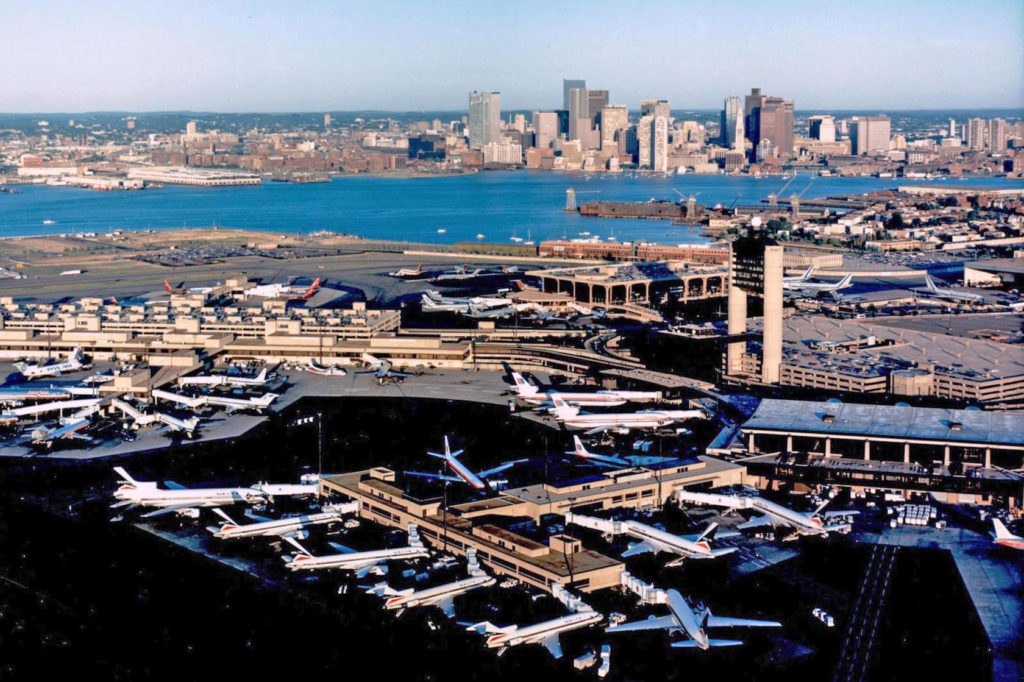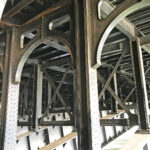Tell Me About This Photo
February 1, 2022
I FOUND THIS picture on the Interwebs. It’s an aerial shot of Boston-Logan, my hometown airport. Judging from the liveries and aircraft types, I’d put the date at 1986, give or take a year.
What a time capsule. We see USAir’s red tails; a United DC-8; a pair of Piedmont 727s; a Delta TriStar; a United DC-8. And most obvious, maybe, is the old terminal A, home to Eastern Airlines. Three of the carrier’s Airbus A300s, which it used on Shuttle routes to La Guardia, are visible. You can’t make it out through the shadows, but the latticed façade and five-story archways of this building bore a likeness to the lower curtain wall of the World Trade Center in Manhattan — and not by accident, for both were the work of architect Minoru Yamasaki. And, standing sentry, there’s Logan’s unmistakable control tower. The 16th floor observation deck would still have been open.
But something else really jumps out at me. And it’s not something we can see. It’s something we don’t see. I want you to study the picture and tell me what’s not there. Air travel in 2022 is quite different from air travel in the 1980s, and a big reason for this difference is the thing missing from this photograph. What is it?
The answer appears on the next line. See if you can figure it out before scrolling.

Photo by Aerial Photography International.
What I’m talking about is the complete absence of regional jets.
No Expresses, no Connections, no Eagles, and so forth. No Canadairs or Embraers. Every single jet in the picture is a mainline jet. This was before the introduction of RJs, at which point the big airlines began the widespread outsourcing of their routes to small-jet contractors.
Small jets did exist in the 1980s (the F-28 for instance), but they burned a lot of fuel and had very high seat-mile costs. It wasn’t until the advent of more efficient planes like the CRJ-200 and the early Embraers that domestic codesharing really took off. By the early 2000s, depending on the airport, forty percent or more of the planes in a photo like this would be regional jets. Love them or hate them, RJs are everywhere.
Many travelers don’t realize it, but the majority of regional airlines have a livery-only affixation with their legacy carrier partners. Some are wholly or partly owned by a major; others are completely independent, but either way they are separate entities, with their own employee groups, pay scales, management structures, and separate FAA operating certificates. (There’s more about this, if you’re interested, in chapter four of my book.)
The term “regional airline” has always been around, but in the old days it meant something different. A “regional” was a major airline whose network concentrated in a particular part of the country. Ozark Airlines, for instance. Or Southern Airways. What today we think of as a regional was called a “commuter.” Commuters fed the majors’ hubs from outlying cities, using turboprops almost exclusively. Look closely at the photo and you can see a couple of turboprop planes. One of them is a Command Airways ATR-42. An independent commuter at the time, Command later became an American Eagle franchise.
The first airline I worked for was a commuter. This was the very early 1990s; maybe we were calling them regionals by then? Our planes flew under the banner of Northwest Airlink, a feeder into Northwest’s Boston hub. We had 15-seaters, 19-seaters, and later a handful 37-seaters. All props. Our network spoked out to places like Burlington, Bangor, Albany, down to Virginia and up into the Canadian Maritimes.
The balance has begun to swing back of late, with the majors taking over a bigger and bigger percentage of routes and frequencies. Driven in part by the pilot shortage, which has forced regional airlines to offer better salaries and working conditions, the cost advantage of RJs has diminished somewhat. For the time being, however, they still comprise a healthy chunk of our flying.
Photo credit: Aerial Photography International.
Related stories:
PLANES, PRANKS AND PRAISE: ODE TO AN AIRPORT
THE SHUTTLE SHUFFLE
POLYESTER, PROPELLERS, AND OTHER MEMORIES
LOOKING OUT: OBSERVATION DECKS, THEN AND NOW





Leave a Comment
Maximum 1500 characters. Watch your spelling and grammar. Poorly written posts will be deleted!
18 Responses to “Tell Me About This Photo”
You are viewing newest comments first. Click to reverse order
I’d adjust your date estimate of this picture given a few clues particularly around Terminal A. There are multiple CO airplanes hard standed along the “hockey stick” which was implemented in very late 86 by Massport (versus three straight lines) along which PT, RP and QO operated. You also can see a CO branded but PE origin 727 tucked along the back of Terminal A which is at a then new gate added to A to accommodate consolidating CO and EA post the 2/1/87 big bang merger. So this is probably very late spring or early summer 87 given that combined with the Command ATR still in Command livery and not yet in AA Eagle paint. Fun stuff!
Oddly enough they are sort of disappearing now, or rather, getting bigger.
Gone are the EMB120s, and CR2s are much fewer nowadays with Delta (IIRC) doing away with all 50-seaters in the near-future (not sure how that’s possible with scope clauses. Maybe it was just one particular regional airline working for them).
While the days of multiple wide-body options on a common citypair are gone, there’s plenty of comfortable rides to be had on an E75 (with wide seating and spacious legroom, though I imagine that is also because of scope limiting them to 76 seats).
You may have missed some of the discussion about the MAX while it was grounded, the airlines were concerned that passengers who had never looked at what equipment was printed on their ticket were going to specify that they would not fly on a MAX. I have no idea if that ever happened once the planes were recertified.
Those people who said they would be afraid to be in the air on a MAX don’t realize that the safest model is the most scrutinized model. What passengers should have been demanding was a pilot bonus for flying the MAX because Patrick Smith said the cockpit is cramped and noisy.
I got it almost immediately 🙂 I do remember the first widely used commuter, the ATR-72, flown by ASA (Atlantic Southeast) at Atlanta. You could do the same game from 1970 and you’d still see Lockheed Electras and Convair 440s. And once in a while, a Delta 747-100 with the classic livery, which was the most awesome sight of my spotting life!
-drl
Regarding what Alan said, I think that passengers would still fly on regionals if they (the regionals) were more independent. It would be just like code-sharing. You book a flight an airline’s website (I assume they would still partner with the majors) and get a flight on another airline.
There’s actually some RJ’s that have the regional’s livery, but they’re rare. If they all wore the regional’s livery, it would be much more interesting!
Wonderful Post! Indeed, IMHO it’s very related to your other post: https://askthepilot.com/20-years-and-counting/ – most traffic has migrated to RJ instead of mainline – and somehow must have influenced in the 20 years statistic. Sad but true…
Before deregulation, airlines like Allegheny, Mohawk, Piedmont, Southern, North Central, Frontier, Ozark, Texas International and Air West were known as local service airlines. They fed passengers from smaller cities to ALL of the major trunk carriers at any big city airport.
The system today is a massive fraud. Both Republic and Skywest fly for the big three. Sometimes on the same route. American and Delta have flights from Kansas City to La Guardia at 6:01am and 6:06am. Both are operated by Republic. United has four flights from KC to Chicago. One on Skywest, one on Mesa and two on Republic.
I remember people pushing for a third airport in the Chicago area to serve the growing market in regional service with more scheduled flights to cities near Chicago. Never mind that most of this traffic would have been much better served environmentally and often time wise (factoring in time to airport, etc.) with modern train service.
Is society really owed eight flights a day from Des Moines to Chicago?
Regional jets are what’s missing. Everything was mainline back then.
I answered immediately on the FB thread but will post here as well.
I wonder sometimes how it would change aviation if the regionals were required to fly under their own names. Are there people who wouldn’t fly on a regional if the ticket, jet and cabin crew were required to carry the regionals name and logo? I don’t know the answer to this but I suspect that there would be fewer regional passengers.
You should post the picture of you standing next to the Spirit of Moncton! I’ll send it to you.
The Big Dig.
Where’s my book?
Even in Europe there’s far fewer regional jets around. This is really primarily a thing in America. I’ve always wondered if this was just another consequence of a) many many smaller airports and b) a lack of strong alternatives (trains).
Wow, a lack of CRJ, ERJ. In Indonesia and Asia where I live, regional jets are smaller in numbers.
True. Asia has its share of LCCs and RJs now, but it’s the one part of the world where it’s not unusual to board a 777 or an A330 for a 35-minute hop.
No regional jets.
It’s so rare to fly on a widebody / 2-aisle plane on a domestic flight anymore, even between large cities such as LA-Chicago, San Fran-Houston, etc. Every once in awhile it happens and I am shocked. Yet I remember flying on L-1011’s between medium sized cities like STL-Las Vegas in the 80s.
The airlines would say that me, the passenger, have driven this trend to more flights on smaller equipment due to our preferences for options to fly at many different times throughout the day. Perhaps. But it is sad to end up with no options for anything other than a 737 or A320 when looking at flights on routes between large cities. I’m sure most don’t purchase tickets and base it off of equipment, but I would be one of them.
Great picture of the good ol’ days, thanks for sharing!
E-Tickets. I was going to guess E-Tickets. Back then I was still getting on Eastern flights with a ticket bought from United or Delta. And vice-versa. The ticket validation would be done on this neat little sticker that overlayed the flight information and written with green ink from a Flair felt-tipped pen.
Ya don’t see any of that in this picture.